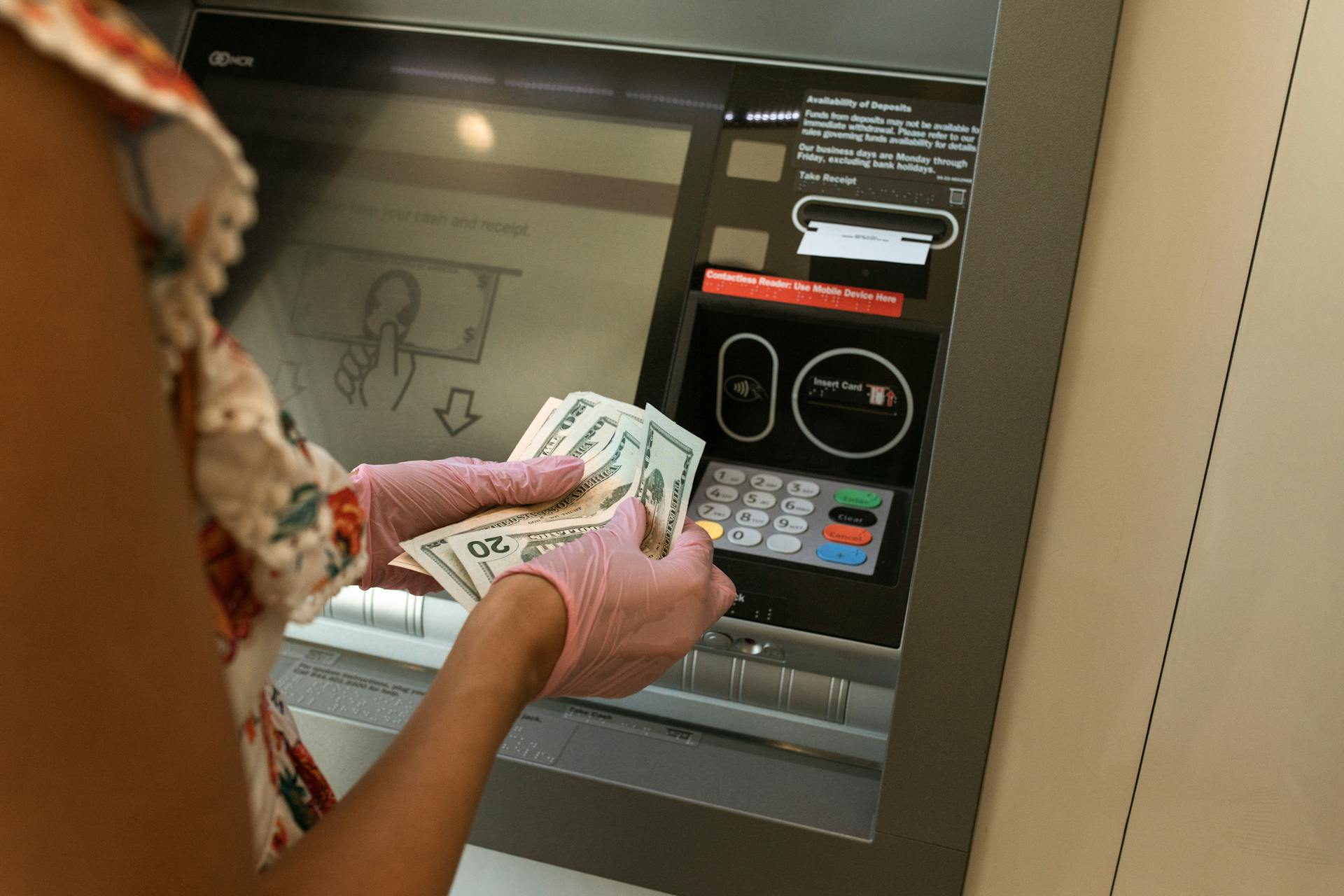
A TD deposit slip is a simple, yet crucial document that helps you deposit funds into your TD Bank account. You can find TD deposit slips at any TD Bank branch or online.
To fill out a TD deposit slip, you'll need to provide your account information, including your account number and routing number. You can find this information on your account statement or by logging into your online banking account.
The deposit slip will also ask you to specify the type of deposit you're making, such as a cash deposit or a check deposit. Make sure to accurately fill out this section, as it will help the bank process your deposit quickly and efficiently.
See what others are reading: Banking Information for Direct Deposit
Understanding TD Deposit Slip
To fill out a TD deposit slip, start by gathering your checkbook and looking for the deposit slip pages, usually found at the back of your checkbook and printed on a different color paper. These pages should have your name, address, and sometimes phone number printed on them.
Explore further: Td Bank Checkbook Order
Your deposit slips should also have your account number printed on them, located at the bottom of the slip. You can find your account number on your checks or by asking a teller after verifying your identity.
When filling out the deposit slip, make sure to include the date and your signature in the designated spaces. If you're depositing cash, write down the full amount in the "Cash" box.
If you're depositing multiple checks, you can list the checks on the back of the deposit slip and write the combined total on the front side. Don't forget to include the subtotal of all your deposits, which is the total of your cash deposit and check deposits.
To calculate your net deposit, subtract any cash you want to withdraw from your subtotal. This will give you the final amount that will be deposited into your account.
Here's a step-by-step guide to filling out a TD deposit slip:
- Fill in the date and your signature
- Write down the amount of cash you're depositing
- List any checks you're depositing and write the combined total
- Calculate your subtotal
- Subtract any cash you want to withdraw from your subtotal to get your net deposit
Remember to double-check all your information before handing it over to the teller.
Finding Your Transit Number
Your TD Bank transit number can be found in various places, but it's often easiest to look at the bottom of a cheque. That's where you'll find the bank transit number and institution number.
If you're having trouble finding your transit number, you can try logging into online banking. Your account, institution, and transit number will be listed there.
You can also find your transit number on a bank-issued cheque or bank statement. It's usually in the same spot as the cheque, at the bottom.
To make sure you have the right number, check that it's 5 digits long. If it's only 4 digits, add a 0 in front. For example, branch 1011 is 01011.
If your account number only has 9 digits, but a form requires 11, simply add two zeros in front. For example, 123456789 is 00123456789.
Here are some examples of TD Bank transit numbers and their corresponding institution numbers:
Writing and Depositing
Writing a deposit slip is a straightforward process. You'll need to include your name and account number, which can be found in your checkbook or mobile banking app.
To fill out a deposit slip, you'll typically need to write down the date of the deposit, your name, and the account number where the check is being deposited into. You'll also need to include the amount of each check being deposited, with each check and check number on its own line.
Here are the basic steps to fill out a deposit slip:
- Write the date of the deposit
- Write your name
- Include the account number where the check is being deposited into
- Include the amount of each check being deposited, with each check and check number on its own line
- Write down a subtotal for all the check amounts
- Write down the total amount of the deposit
You can find deposit slips at bank and credit union branches, or in the back of your checkbook.
Writing a Check
Writing a check can seem intimidating, but it's actually quite straightforward. To write a check, you'll need to include the date of the deposit, your name, the account number where the check is being deposited into, and the amount of each check being deposited.
Make sure to write down each check and check number on its own line. This will help prevent any errors or confusion when the check is processed. You can find preprinted deposit slips in your checkbook, which usually include your name, account number, routing number, and your bank's or credit union's name.
To deposit a check, you'll typically need to fill out a deposit slip. This involves writing down the date of the deposit, your name, the account number where the check is being deposited into, and the amount of each check being deposited.
Here are the basic steps to fill out a deposit slip:
- Write down the date of the deposit.
- Write down your name.
- Include the account number where check is being deposited into.
- Include the amount of each check being deposited in the area designated for checks. Each check and check number must go on its own line.
- Write down a subtotal for all the check amounts.
- Write down the total amount of the deposit.
Remember to sign the check and include your address in the top right corner. This may seem like a lot to remember, but it's actually quite simple once you get the hang of it.
Depositing Multiple
Depositing Multiple Checks can be a bit tricky, but it's actually quite straightforward. You'll need to list each check and check number on its own line in the designated area on the deposit slip.
The good news is that the process is essentially the same as depositing a single check. You just need to repeat the process for each check you're depositing.
The deposit slip should have a section for listing multiple checks, so you can take advantage of that space to make things easier.
If you're depositing several checks, be sure to include the account number where the check is being deposited into, just like you would for a single check.
You'll also need to write down the amount of each check, and don't forget to include the check number on its own line.
A deposit slip for multiple checks might look a bit more crowded than one for a single check, but it's still a straightforward process.
A fresh viewpoint: How to Order Personal Checks
How to Fill Out a Form
To fill out a deposit slip, you'll need to include your name and account number, which is usually between eight to 12 digits.
You can find your account number in your checkbook, mobile banking app, or by asking a teller after verifying your identity. The date you write on the deposit slip should be the current date, not the date noted on any checks you're depositing.
If you're depositing cash, enter the total dollar amount plus any change and endorse any checks you're depositing. If you're depositing multiple checks, write the amount of each one on a separate line on the slip.
The subtotal of all your deposits is the total of the cash and check amounts. If you're not cashing any, your net deposit will be the same as your subtotal. If you're cashing out some or all of the deposit, write how much you want withdrawn on the less cash line and subtract that from your subtotal to get your net deposit.
To deposit the slip, give it to the teller in the bank's lobby or through the teller drive-thru along with the cash and/or checks you're depositing.
Here's a step-by-step guide to filling out a deposit slip:
1. Add your info, including your name and bank account number.
2. Write the current date.
You might enjoy: Depreciation Expense Straight Line Method
3. Write the total amount of cash and endorse any checks.
4. Determine your total by adding up the cash and check amounts.
5. Deposit the slip with the teller.
Note that most banks offer deposit slips with clear lines to fill out, so be sure to add up your subtotal and net deposit correctly.
Signing Requirements
Signing a deposit slip can be a straightforward process, but it's essential to get it right.
You usually need to sign the deposit slip in blue or black ink if you're keeping some or all of the cash from a check and cash deposit.
A signature is generally not required if you're depositing the entire check amount without taking any cash.
Make sure to include any other required information on the deposit slip, such as your account details.
A fresh viewpoint: Cash Advance Apps No Direct Deposit Required
Frequently Asked Questions
Can you get a bank deposit slip online?
Yes, you can easily obtain a bank deposit slip online through OnlineCheckWriter.com, which connects with over 22,000 US and Canadian banks. Simply access the platform from your home or office to create a deposit slip for any bank.
Where to find direct deposit slip on TD?
Find your direct deposit information in the TD app by navigating to Accounts > Summary > Direct Deposit Information
Featured Images: pexels.com


